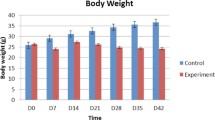Abstract
Ligation of the left anterior descending (LAD) coronary artery in the mouse heart is a widely used model to simulate myocardial infarction and ischemia–reperfusion injury. Here we describe a ligation technique routinely performed in our laboratory to induce myocardial infarction that may be used to study ischemia–reperfusion injury in the myocardium. The methods described enhance location of the LAD coronary artery to allow for accurate ligation, thus increasing reproducibility of infarct size and location.
Access this chapter
Tax calculation will be finalised at checkout
Purchases are for personal use only
Similar content being viewed by others
References
Go AS, Mozaffarian D, Roger VL et al (2014) Heart disease and stroke statistics—2014 update a report from the American Heart Association. Circulation 129:28–292
Abarbanell AM, Herrmann JL, Weil BR et al (2010) Animal models of myocardial and vascular injury. J Surg Res 162:239–249
Smith FM (1918) The ligation of coronary arteries with electrocardiographic study. Arch Intern Med XXII:8–27. https://doi.org/10.1001/archinte.1918.00090120013002
Johns TNP, Olson BJ (1954) Experimental myocardial infarction: I. A method of coronary occlusion in small animals. Ann Surg 140:675–682
Maroko PR, Libby P, Ginks WR et al (1972) Coronary artery reperfusion. J Clin Invest 51:2710–2716
Pfeffer MA, Pfeffer JM, Fishbein MC et al (1979) Myocardial infarct size and ventricular function in rats. Circ Res 44:503–512
Michael LH, Entman ML, Hartley CJ et al (1995) Myocardial ischemia and reperfusion: a murine model. Am J Physiol 269:2147–2154
Degabriele NM, Griesenbach U, Sato K et al (2004) Critical appraisal of the mouse model of myocardial infarction. Exp Physiol 89:497–505
Kumar D, Hacker TA, Buck J et al (2005) Distinct mouse coronary anatomy and myocardial infarction consequent to ligation. Coron Artery Dis 16:41–44
Salto-Tellez M, Yung Lim S, El-Oakley RM et al (2004) Myocardial infarction in the C57BL/6J mouse: a quantifiable and highly reproducible experimental model. Cardiovasc Pathol 13:91–97
Xu Z, Alloush J, Beck E, Weisleder N (2014) A murine model of myocardial ischemia-reperfusion injury through ligation of the left anterior descending artery. J Vis Exp. https://doi.org/10.3791/51329
Virag JAI, Lust RM (2011) Coronary artery ligation and intramyocardial injection in a murine model of infarction. J Vis Exp. https://doi.org/10.3791/2581
Shao Y, Redfors B, Omerovic E (2013) Modified technique for coronary artery ligation in mice. J Vis Exp. https://doi.org/10.3791/3093
Tarnavski O, McMullen JR, Schinke M et al (2004) Mouse cardiac surgery: comprehensive techniques for the generation of mouse models of human diseases and their application for genomic studies. Physiol Genomics 16:349–360
Gao E, Lei YH, Shang X et al (2010) A novel and efficient model of coronary artery ligation and myocardial infarction in the mouse. Circ Res 107:1445–1453
Borst O, Ochmann C, Schönberger T et al (2011) Methods employed for induction and analysis of experimental myocardial infarction in mice. Cell Physiol Biochem 28:1–12. https://doi.org/10.1159/000331708
Diepenhorst GMP, van Gulik TM, Hack CE (2009) Complement-mediated ischemia-reperfusion injury: lessons learned from animal and clinical studies. Ann Surg 249:889–899
Author information
Authors and Affiliations
Corresponding author
Editor information
Editors and Affiliations
Rights and permissions
Copyright information
© 2018 Springer Science+Business Media, LLC
About this protocol
Cite this protocol
Xu, Z., McElhanon, K.E., Beck, E.X., Weisleder, N. (2018). A Murine Model of Myocardial Ischemia–Reperfusion Injury. In: Tharakan, B. (eds) Traumatic and Ischemic Injury. Methods in Molecular Biology, vol 1717. Humana Press, New York, NY. https://doi.org/10.1007/978-1-4939-7526-6_12
Download citation
DOI: https://doi.org/10.1007/978-1-4939-7526-6_12
Published:
Publisher Name: Humana Press, New York, NY
Print ISBN: 978-1-4939-7524-2
Online ISBN: 978-1-4939-7526-6
eBook Packages: Springer Protocols




